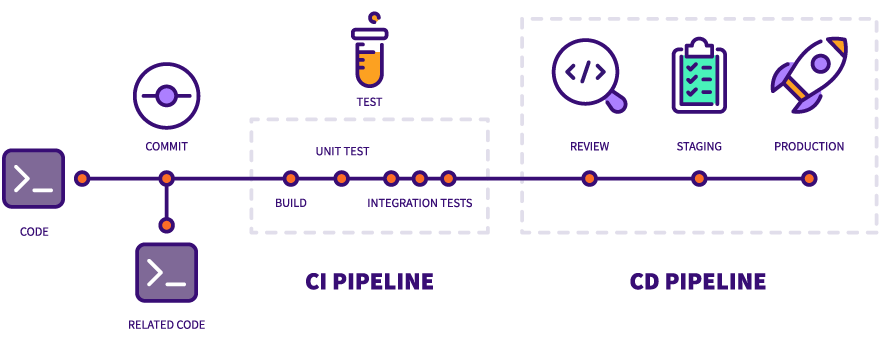In today’s software product development world, application development teams are under immense pressure to release new features as quickly as possible. However, every effort to expedite planning, coding, and testing is futile if the release doesn’t go smoothly. Organizations are increasingly relying on CI/CD to build, test, update, and deliver their software products more regularly.
In this blog, we’re taking a detailed look at Continuous Integration and Continuous Delivery and how it can help organizations thrive in a dynamic software development industry. Keep reading to learn more.
What Does CI/CD Mean?

What are Why is CI/CD Important?
With CI/CD, businesses can ship their software more quickly and effectively as it automates the process of integrating, releasing, and deploying software. It enables the continuous flow of new features and security patches through the most efficient delivery method, while also removing traditional drawbacks. By continuously delivering code into production, companies can bring products to market much faster than before.
What is the Difference Between CI and CD?
Continuous Integration
The agile approach requires developers to split up their work and create new features more quickly. However, with more changes comes more conflict. So, while integrating code, developers often face issues. Also known as Integration Hell, this process is one of the hardest parts of the software development process. It is almost never smooth, and often requires long hours or even days of re-fixing code before the new code from individual developers can ultimately integrate with the rest of the code in the system. Continuous integration is an automation strategy that is designed to address these integration challenges. It creates workflows that compile code changes regularly, build the app, and also test the updated version for inconsistencies and errors.
With this strategy, any integration issues that arise will be much less complex and easier to resolve, as different branches of code are continuously merged into a shared branch, rather than at the end of the coding phase.
Once the changes have been integrated, the application is built in a demo environment and tested for bugs and errors. Developers can quickly identify and rectify any vulnerabilities that are discovered before writing more code.
After Continuous Integration comes Continuous Delivery.
Continuous Delivery
The Distributed DevOps model presents a challenge of visibility and communication between development and business teams. This lack of end-to-end visibility could hinder the work of DevOps teams. Continuous Delivery aims to solve this challenge by enabling DevOps teams to deliver production-ready code faster and with minimal effort.
Continuous Delivery typically refers to the process where a developer’s changes to an app are immediately released to a shared repository like GitHub or a container registry after being tested for bugs. Testing the code during CI is essential for this process because otherwise faulty code gets delivered automatically, resulting in bugs that are subsequently pushed to production. Once the code is released to the shared repository, the operations team can then deploy it to a live production environment.
The final stage in the CI/CD pipeline is Continuous Deployment.
Continuous Deployment
Continous Deployment is an extension of the Continuous Delivery process. In this final stage, developer changes are automatically released from the repository to production, where it can be used by end users. This process accelerates the feedback loop with the customers and requires no human intervention. Continuous Deployment alleviates the operations team’s burden of manually deploying releases which could be many based on the development team’s schedule and speed.Are CI/CD and DevOps the Same?
DevOps is a mindset that emphasizes communication and collaboration among developers and testers. It focuses mainly on culture and role constraints and defines a set of ideas, practices, processes, and technologies that help with the development of products. Companies that follow the DevOps methodology bridge the gap between Operations and Engineering by cross-training each team in the skills of the other. This method improves everyone's capacity to appreciate and participate in each other's tasks, resulting in better collaboration and regular communication. DevOps methodologies help organizations in establishing production teams and processes that facilitate rapid, continuous deployment of software.

Whereas, (CI/CD) refers to the continuous automation and monitoring of the application lifecycle - right from integration and testing to product delivery and deployment. When properly implemented, CI/CD allows for the frequent delivery of software changes to production. This provides more opportunities for customers to provide feedback, promoting an agile development culture.
Essentially, CI/CD is a DevOps strategy that utilizes the proper automated testing tools to execute agile development in the organization.
Both practices have the same objective - to produce better software in lesser time.
Benefits of CI/CD
CI/CD implementation can massively boost the value stream of your business. This section highlights the top 5 ways in which CI/CD can benefit your organization.
Shorter Time to Market
Today’s market is extremely competitive with companies releasing new features constantly. A streamlined CI/CD process has the tools and frameworks that enable these rapid release cycles. Being able to implement changes quickly and confidently allows you to respond to the latest trends and address pain points as they come up.
Lower Risk
With CI/CD you have the ability to test your experiments and innovations with your users early on in the development process. Validating your approach in the testing phase is crucial as it can save you from investing time and money on features that don’t truly solve the problems of your customers.
In addition, CI/CD allows testers to detect and fix bugs as soon as they show up. This real-time risk mitigation enables faster and more frequent testing and deploying of code.
Higher Quality Code
Running automated tests on each and every code build is an integral part of the CI/CD pipeline. Since automated tests are faster and easier to run, they ensure that the code is tested consistently, ensuring better quality code.
Measurable Growth
CI/CD tools provide a multitude of metrics, ranging from build times to test coverage, and test fix times. With this information, you can identify areas that require attention and continue to improve your pipeline. Additionally, you can also see how the CI/CD pipeline is supporting your organization.
Smaller Code Changes and Error Isolation
CI/CD allows for the integration of smaller pieces of code in regular intervals rather than huge chunks of code all at once. These small pieces of code are easier to integrate and make it easy to identify issues before more code is built on top of it.
Fault isolation is the practise of designing systems so that when a fault appears, the negative consequences are limited. A system designed with CI/CD can detect and resolve fault isolations faster.
Both of these can help to prevent the occurrence of bugs and errors in the final stages.
CI/CD Tools
CI/CD software tools are used by development teams to automate parts of the application build and to document the development process. These tools are an essential component of the software development process. From automating workflows, reducing task complexity, to managing code changes and security flaws more effectively, selecting the right toolkit for the job at hand is critical.
Listed below are the most popular CI/CD tools in 2022:
Jenkins
Jenkins is an open-source automation server that hosts the central build and continuous integration processes. A leading CI/CD tool in the market, it offers hundreds of plugins that support building, deploying, and automating for software development processes.
Circle CI
CircleCI is a tool that enables rapid software development, publishing and automation throughout the user's pipeline, from code creation to testing and deployment. CircleCI can be integrated with GitHub, GitHub Enterprise, and Bitbucket.
GitLab
GitLab is an open source web-based Git repository manager with wiki, issue tracking, and CI/CD pipeline features. It provides a wide range of tools for managing various stages of the software development lifecycle.
JetBrains TeamCity
TeamCity is a CI tool that is Java-based and integrates with Visual Studio and other Integrated Development Environments. With TeamCity, developers can test code before committing it to a codebase.
Bamboo
Bamboo is a CI server that creates a CD pipeline by automating the management of software application releases. It is an on-premises tool that combines automated build, tests, and releases into one workflow.
Conclusion
DevOps and CI/CD are two of the most effective and efficient software development methodologies. When properly implemented, they play an important role in the development of software that consistently meets and surpasses customer expectations.
Fulfill Your App Development Requirements with Threat Intelligence
Integrating automated security testing into your DevOps pipeline, regardless of the size of your organization, is difficult and can take months of planning and involve substantial project costs.
Evolve Automated DevOps Application Security Testing
assists businesses in orchestrating and automating the integration of application security testing into their DevOps pipelines. It provides the most efficient security controls for software moving from development to production. In addition to achieving unparalleled efficiencies, your applications will also be more secure than ever. To learn more about how this solution works,
book a demo
with one of our security specialists today.






